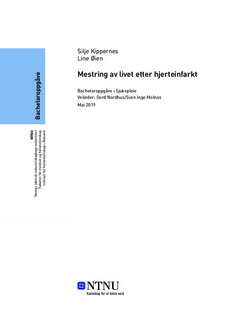| dc.contributor.advisor | Nordhus, Gerd | |
| dc.contributor.advisor | Molnes, Sven Inge | |
| dc.contributor.author | Kippernes, Silje | |
| dc.contributor.author | Øien, Line | |
| dc.date.accessioned | 2019-09-06T14:10:54Z | |
| dc.date.available | 2019-09-06T14:10:54Z | |
| dc.date.issued | 2019 | |
| dc.identifier.uri | http://hdl.handle.net/11250/2613524 | |
| dc.description.abstract | Hensikt: Hensikta med oppgåva er å få perspektivet til pasienten om kva erfaringar dei har gjort med mestring etter hjerteinfarkt. Ved å reflektere over dei funna som er presenterte i denne oppgåva, kan sjukepleiarar og helsepersonell bidra til å legge til rette for og støtte pasienten i mestringsprosessen.
Metode: Systematisk litteraturstudie.
Resultat: Å få hjerteinfarkt er ei livskrise, og pasientar handterer sjukdommen sin ulikt. Ved å forstå ulike mestringsstrategiar og ulike stressreaksjonar, kan helsepersonell bidra til at pasientane klarer å mestre livet etter hjerteinfarkt. Etter at pasientane er utskrivne frå sjukehus, har pasientane ulik forståelse og oppfatning av egen livssituasjon og helse. Pasientane har eigenopplevde behov gjennom mestringsprosessen. Fatigue var ein faktor mange av pasientane opplevde som uforståeleg og vanskeleg å forklare. Ved negativ mestring kan pasientane ta passive valg, stritte imot kroppens signal og/eller halde fram med same livsstil som før hjerteinfarktet. Ved positiv mestring vil pasientane aktivt gjere tiltak for å endre og tilpasse seg konsekvensane etter hjerteinfarktet.
Konklusjon: Det som gjer at nokre får til ei positiv mestring er korleis den enkelte forstår kva sjukdommen er, kvifor den har oppstått, samt aksepterer at dei sjølve kan påverke eiga helse framover – altså om ein har ei høg eller lav oppleving av samanheng (OAS). Ved lav OAS så er det sannsynleg at pasienten mestrar livet negativt. Pasientane treng støtte og informasjon rundt sjukdommen for å kunne erfare høg OAS. Helsepersonell må ha kunnskap om sjukdom, mestringsstrategiar og stressreaksjonar, for å støtte pasientane som treng hjelp til å oppnå høg OAS slik at fleire pasientar kan oppnå positiv mestring. | |
| dc.description.abstract | Aim: The purpose of this study is to get the patient's perspective on their experiences regarding how they cope after a heart attack. By shedding light on the findings, nurses and health personnel can obtain a better understanding of how to support the patient in the coping process.
Method: Systematic literature study.
Results: Getting a heart attack is seen as a life crisis, and patients handle their disease differently. By understanding different coping methods and various stress reactions, health professionals can help patients master their life after heart attack. After patients have been discharged from the hospital, the patients have different understanding and perception of their own life situation and health. Patients have self-experienced needs throughout the coping process. Many patients experienced fatigue as incomprehensible and difficult to explain. In the case of negative coping, the patients will remain passive, struggle against the body's signal and/or continue with the same lifestyle they had before the heart attack. In the case of positive coping, the patients will actively take measures to change and adapt to the consequences after the heart attack.
Conclusion: What makes some people adapt a positive way of coping is how the individual understands what the disease is, why it has occurred, and accepts that they can influence their own health in the future – meaning, whether one has a high or low sense of coherence (SOC/OAS ).
With a low SOC, the patient is likely to master life negatively. Patients need support and information about the disease in order to experience high SOC. Healthcare professionals need to have knowledge of disease, coping mechanisms and stress reactions, to support patients who need help to achieve high OAS so that more patients can achieve positive coping. | |
| dc.language | nno | |
| dc.publisher | NTNU | |
| dc.title | Mestring av livet etter hjerteinfarkt | |
| dc.type | Bachelor thesis | |
